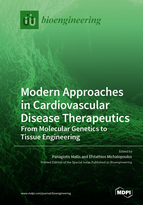Modern Approaches in Cardiovascular Disease Therapeutics: From Molecular Genetics to Tissue Engineering
A special issue of Bioengineering (ISSN 2306-5354). This special issue belongs to the section "Regenerative Engineering".
Deadline for manuscript submissions: closed (31 August 2021) | Viewed by 29901
Special Issue Editors
Interests: immunobiology of stem cells; molecular genetics of HLA; tissue-engineered small-diameter vascular grafts; immunobiology of biological scaffolds; mesenchymal stromal cells; hematopoietic stem cells biology
Special Issues, Collections and Topics in MDPI journals
Interests: tissue engineering; regenerative medicine; mesenchymal stromal cells; hematopoietic stem cells; vascular grafts; immunobiology; platelet gel
Special Issues, Collections and Topics in MDPI journals
Special Issue Information
Dear Colleagues,
Cardiovascular disease (CAD) is the leading cause of death, globally, of all the non-communicable diseases. CAD is a group of complex disorders which includes peripheral arterial disease, coronary heart disease, cerebrovascular disease, and rheumatic heart disease. Each year, more than 800,000 bypass surgeries are performed. Additionally, it is speculated that more than 17 million of people have died due to CAD, representing approximately 31% of all deaths worldwide.
It has been speculated that CAD costs the European Union (EU) more than 210 billion euros, and more than 300 billion dollars in the case of the United States of America (USA). The primary cause for the development of CAD is atherogenesis and developed atherosclerosis, which induces functional alterations to the vessels of the circulatory system. In this process, an individual’s genetic background may influence the progression of this disease. Indeed, among other factors, genetic alterations regarding the function of immune cells and the human leukocyte antigen (HLA) system play a crucial role in the pathogenesis of CAD. In better understanding better an individual’s genetic alterations, which are specific for the initiation and progression of CAD, novel targets for advanced therapeutics may be revealed.
Advanced approaches for CAD prevention also involve the use of suitable tissue-engineered vascular grafts (TEVG) for bypass surgeries. The gold standard conduits for this purpose are the Dacron- or ePTFE-derived vascular grafts. In addition, autologous grafts, such as saphenous vein, have also been applied in the past. Unfortunately, less than 40% of patients have autologous vessels suitable for this purpose. Additionally, animal-derived vessels have been tested for their suitability as conduits. Recently, the production of TEVG using decellularization methods has gained significant attention from the scientific society. In the aforementioned approaches, the mechanical properties of the produced grafts are at the center of the attention, and their study may reveal valuable information regarding their structure–function properties.
Modern approaches for CAD will take into account individual’s own characteristics, promoting, in this way, advanced personalized therapeutic strategies in accordance with the conditions of good manufacturing practices (GMP).
We are delighted to present the current Special Issue entitled “Modern Approaches in Cardiovascular Disease Therapeutics: From Molecular Genetics to Tissue Engineering”. This collection of articles will involve the most relevant and state-of-the-art research related to the topic of the Special Issue, including:
- Molecular analysis of cardiovascular disease
- Novel biomarkers of cardiovascular disease
- Population genetics and association with cardiovascular disease
- Novel approaches for cardiovascular disease administration
- Vascular grafts and their application in cardiovascular disease
- Biomechanical properties of TEVG
We invite researchers to submit original research articles, short communications, reviews, and opinion articles that meet the aim of the current Special Issue. We look forward to receiving your valuable contributions.
Dr. Panagiotis Mallis
Dr. Efstathios Michalopoulos
Guest Editors
Manuscript Submission Information
Manuscripts should be submitted online at www.mdpi.com by registering and logging in to this website. Once you are registered, click here to go to the submission form. Manuscripts can be submitted until the deadline. All submissions that pass pre-check are peer-reviewed. Accepted papers will be published continuously in the journal (as soon as accepted) and will be listed together on the special issue website. Research articles, review articles as well as short communications are invited. For planned papers, a title and short abstract (about 100 words) can be sent to the Editorial Office for announcement on this website.
Submitted manuscripts should not have been published previously, nor be under consideration for publication elsewhere (except conference proceedings papers). All manuscripts are thoroughly refereed through a single-blind peer-review process. A guide for authors and other relevant information for submission of manuscripts is available on the Instructions for Authors page. Bioengineering is an international peer-reviewed open access monthly journal published by MDPI.
Please visit the Instructions for Authors page before submitting a manuscript. The Article Processing Charge (APC) for publication in this open access journal is 2700 CHF (Swiss Francs). Submitted papers should be well formatted and use good English. Authors may use MDPI's English editing service prior to publication or during author revisions.
Keywords
- cardiovascular disease
- biomarkers
- genetic alterations
- HLA
- TEVG
- biomechanics
- GMPs








